An engineering marvel, the 992 delivers broad excellence, enthusiast disappointment
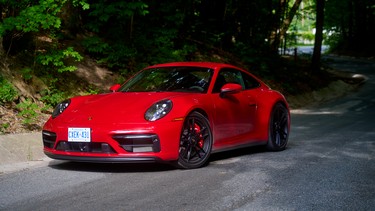
Article content
The 992-generation 911 delivers well-near the best of performance motoring, and that’s a crying shame.
Engineered to Stuttgart’s insatiable standards, the 992 holds a formula that shouldn’t work — an engine hung past the rear axle — and executes better than many of its orthodox peers.
Advertisement 2
Article content
Though grouped under one nameplate, the Porsche 911 spans enough models to make a Mercedes brochure tremble. Mainline 911s span two branches and 16 models, above which stand a quartet of 911 Turbo flagships and a further five niche enthusiast variants. All-wheel-drive mainline models are distinguished by the numeral ‘4’, while 911 Turbos equip AWD to manage their enormous power.
The Porsche 911 Carrera 4 GTS is the meatiest of the 911’s mainline, 3.0-litre incarnations. Mating a turbocharged flat-six engine to your choice of manual or ‘PDK’ double-clutch automatic transmission, the C4 GTS turns 473 horsepower and 420 lb-ft of torque for 0-100-km/h acceleration in as few as 3.3 seconds.
There are supercars slower than this, yet, the 992 doesn’t shout for attention like many of its high-performance peers. Whereas the BMW M4 begs you to take it seriously as a fast car, the 911 sells on luxury and lifestyle, and while it’s easy to forget, it just happens to be hyper-competent at going fast as well.
Advertisement 3
Article content
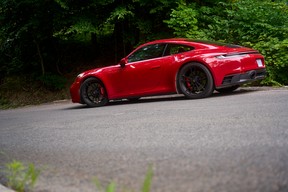
Equipped with Porsche’s industry-best PDK transmission, the 992 cruises with unparalleled smoothness and imperceptible speed. Driven aggressively in automatic mode, shift points are cleverer and better-timed than even a professional driver might hope to accomplish. Power is thus abundant and always available, but drivers are welcome to override this and shift themselves if they want to participate. In this event, the 992’s shift paddles are a unique pleasure: milled from solid aluminum, their fingertip heft and crisp magnetic release are unmatched in today’s market, excepting McLaren’s unitary shifter in the Artura.
More importantly, however, the 992 is still available with a seven-speed manual gearbox. Though three-pedal shifts drag the C4 GTS’ acceleration back to a lazy 3.7 seconds, Porsche has retained such a satisfying and worthwhile action, enabling the manual 992 to shift rather like Alcantara feels.
Is the 911 comfortable?
Advertisement 4
Article content
Channelling all of this is an elegant suite of chassis- and traction management controls that make the GTS astonishingly easy to handle at pace. Bonk the throttle too eagerly through a corner, and the 992 will torque- and brake-vector the car around whatever axis your steering inputs request. Traction is so difficult to break that the GTS’ Bridgestone Eagle F1s typically only register sound as they drum over coarse asphalt.
For its part, that drumming resonance is one of the 992’s greater shortcomings. With wind and other noises so effectively filtered by the 911’s sound deadening and laminated glass, the car’s enormous tire sections resound noticeably and unpleasantly. Similarly underwhelming is that although Porsche’s PASM adaptive damping is surely appreciated for stability at speed, it doesn’t afford the Multimatic-style range that would likewise glide the car over bumps without a driver noticing.
Advertisement 5
Article content
-
![Porsche should put its 911 Heritage cars into more hands]()
Porsche should put its 911 Heritage cars into more hands
-
![Driving to find the history and meaning of Porsche's GTS line]()
Driving to find the history and meaning of Porsche’s GTS line
Fortunately, the 911 range comes out strong on seating. Even Porsche’s most aggressive buckets are surprisingly comfortable on long journeys (if awkward to enter), and in the case of this tester’s more accessible 18-way seats, adjustability makes the experience particularly welcoming. The 992 accommodates significant vertical and pitch adjustment to suit short and tall drivers, with further switches for bottom and side bolsters to ensure optimal hug support without too much of a squeeze.
Infotainment and controls in the 911
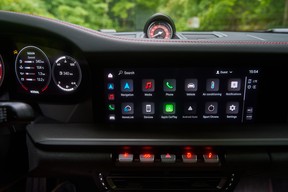
The 992-generation 911 presents a significantly tidier centre console than the recent 991 or 997 generations. Several features have migrated into infotainment, though Porsche has fortunately kept hard buttons for climate and select functions such as sport damping and exhaust (if equipped) at hand below this screen. These highlighted switches knock with satisfying detents and feel high in quality.
Advertisement 6
Article content
Infotainment menus are straightforward and intuitive, and the car’s wireless device projection finally supports Android Auto alongside Apple CarPlay.
Porsche’s new-generation cabin deploys piano black materials to handsome effect, though still with the frustrations of fingerprints, dust-wipe scratches, and blinding midday glare.
Steering controls are logical, though their matte-finish hard plastics don’t satisfy the fingers with quite the same luxury feeling of those in the centre. Particularly weak here is the Sport Chrono drive-mode knob — a key selling feature for the GTS trim — which protrudes from the steering pad’s four-o-clock position and creaks if tugged on.
The 911 is too good for its own good
Advertisement 7
Article content
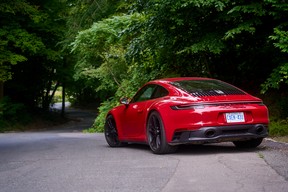
The current 911’s greatest flaw is its lack of flaws. Through decades of evolution and refinement, Porsche has engineered many of the charming foibles and characteristics out of its curious rear-engined icons — and with them, much of their personality.
Having grown so unflappably, antiseptically competent, the Porsche 992 has thus lost the edge that demanded a driver’s respect, attention, and commitment to learning its tastes and ways.
This is objectively good — it makes the Porsche 911 incredibly approachable and relatively safe to drive quickly. Particularly when equipped with PTV and PASM, the 911 unflinchingly filters out ‘incorrect’ inputs and redirects the car the way its engineers say it should go, as if to gently take a driver’s hand and say “here’s what you meant to do.”
Advertisement 8
Article content
Unfortunately, this means that the car is hard to bring to life until taken to a track.
The GTS’ outright speed will surely be enough for some of the simpler, muscle-minded crowd, but twisty-oriented enthusiasts may grow tired of caging its hyper-capable throttle.
Porsche 911 key options and Canadian pricing
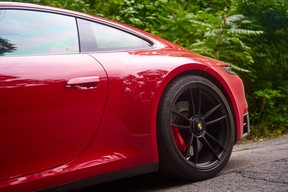
The 2023 Porsche 911 starts from $136,300 in Canada, but the Carrera 4 GTS starts from $181,700 before retail and luxury taxes. After taxes, typical options, and fees, many 992 C4 GTS shoppers will be looking at a near-quarter-million-dollar invoice — an admittedly steep price for not-a-911-Turbo, not that Porsche will have any trouble moving every unit it allocates to Canada.
The unit tested for this review carries a dealer invoice price of $204,090 before taxes and retail-side fees. This includes $3,150 for an excellent front lift option, which can save GPS coordinates to automatically lift when you arrive at frequently traversed curbs, humps, or holes.
Advertisement 9
Article content
Porsche Dynamic Chassis Control is a $3,610 upgrade.
A $6,120 Premium Package adds a handful of desirable features including richly detailed Bose premium audio, power-folding mirrors, ambient mood lighting that can match the album-art hues of a currently playing track, parking assist, and a sharp but awkwardly distorted 360-degree camera view which makes objects appear dangerously close even when several feet away.
Bose audio can be equipped on its own for $1,820; the Burmester will set you back $6,350.
Adaptive Cruise Control is an attractive upgrade at $2,280, equipping this highway-ready tourer with smooth, trustworthy, stop-start ready speed and brake control.
Available on the GTS, a $9,910 Lightweight Package is also fitted to this unit — really a take-it-or-leave-it option. This package saves 25 kilograms with a lighter lithium-iron phosphate (LFP) battery, thinned dual-pane acoustic glass, and the removal of the car’s rear seats. Slightly perplexing here is the inclusion of rear-axle steering within this package, a welcome addition that makes the car much more maneuverable but obviously offsets some of those weight savings.
Advertisement 10
Article content
Less necessary are this unit’s $5,170 GTS interior package and handsome but costly $4,520 interior matte carbon trim details.
Carbon-ceramic brakes are off the menu ahead of upcoming regulatory changes, but seem largely unnecessary here — indeed, ask around at a PCA track day, and most of the experienced folks will swear by the standard steel brakes for economically sustainable enthusiast use. Squeezed with a satisfyingly firm press of the brake pedal, the 13.8- and 13-inch rotors on the GTS team with the wide tires’ tremendous traction for plenty of stopping power — even at the 992’s hefty 1.5-ton curb weight.
Which Porsche 911 would we buy?
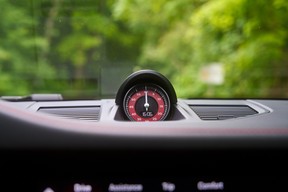
The 992 GTS is an attractive and high-performing everyday sports car, but sits higher than seems necessary. The model’s bonus horsepower are fun, but standard GTS features like Porsche’s Sport Chrono will go unused by the overwhelming majority of drivers; serious track enthusiasts, meanwhile, will be better served by a dedicated Garmin timing and telemetry unit.
Advertisement 11
Article content
The 911 Carrera S — either in standard RWD or 4S AWD configurations — is a better value with a more focused standard set of feature content, while still retaining plenty of leeway for customization as a customer sees fit.
Porsche 911 competitors
The 911 has outlasted generations of peers and competitors, and has edged further ahead (if up in price) with each iteration. Today’s two-door luxury sports segment is limited.
The BMW M4 offers comparable power at similar pricing, and is likewise still available with a manual transmission. The BMW’s electric power steering dulls its personality. New for 2023, the new Mercedes-AMG C 63 Coupe drops its traditional V8 powertrain for a hybridized 2.0L four-cylinder. Jaguar’s outgoing F-Type offers comparable power for less money, but without any match to the refinement, capability, and assured feeling of quality offered by the 911.
Perhaps the 911’s most important competition, then, is its own sibling — the 718 Boxster and Cayman. The 718 is the more dynamic driver’s car in the lineup, and specced with the 4.0L flat-six GTS trim, the only way to get a naturally aspirated Porsche sports car in this era of turbocharging.
Pros
✔ Excellent refinement and controllability
✔ Accessible power
✔ Strong value retention
Cons
✘ Sterile character
✘ Harsh ride in the city
✘ Confusing parking camera perspectives
Stay connected with us on social media platform for instant update click here to join our Twitter, & Facebook
We are now on Telegram. Click here to join our channel (@TechiUpdate) and stay updated with the latest Technology headlines.
For all the latest Automobiles News Click Here

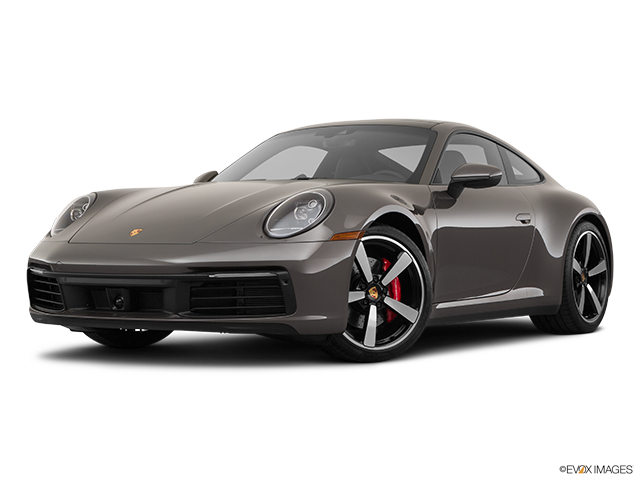
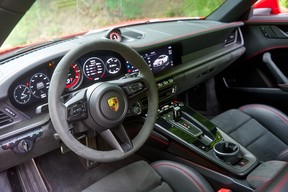
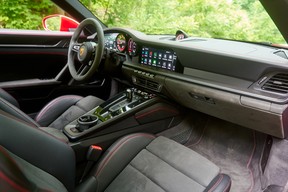
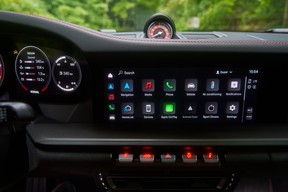
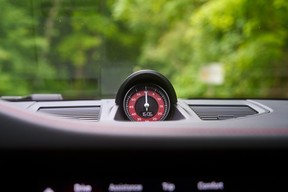
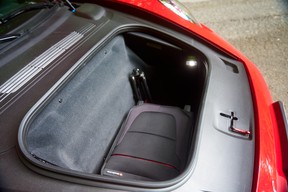



Comments
Postmedia is committed to maintaining a lively but civil forum for discussion and encourage all readers to share their views on our articles. Comments may take up to an hour for moderation before appearing on the site. We ask you to keep your comments relevant and respectful. We have enabled email notifications—you will now receive an email if you receive a reply to your comment, there is an update to a comment thread you follow or if a user you follow comments. Visit our Community Guidelines for more information and details on how to adjust your email settings.
Join the Conversation